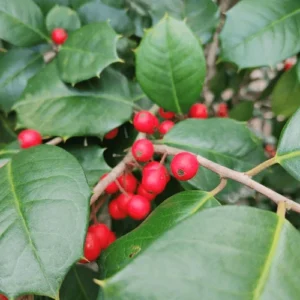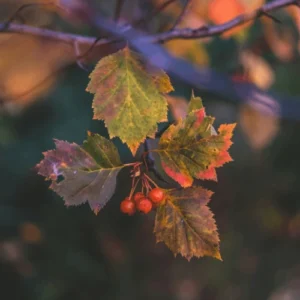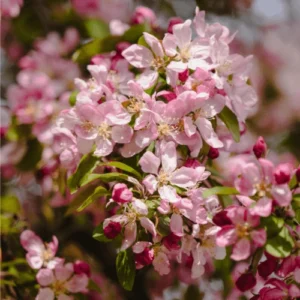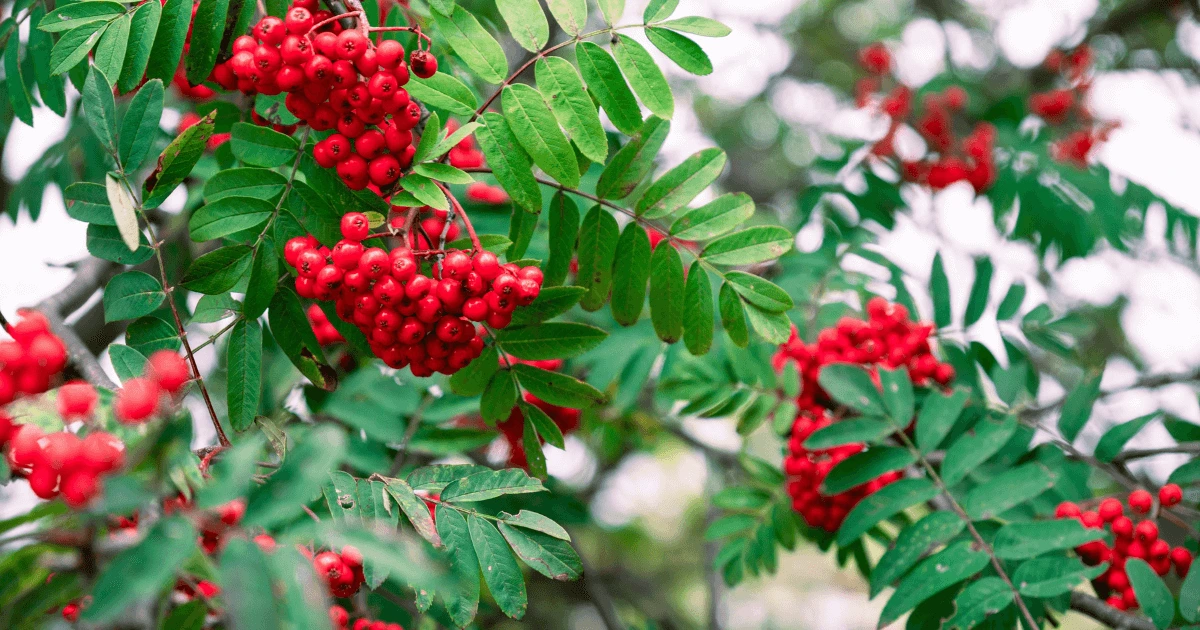Have you ever walked through a garden and been captivated by the sight of bright red berries glowing against the stark winter landscape? Trees with red berries bring a unique charm to any outdoor space, offering vibrant color when most plants are dormant. But these trees are more than just eye-catching—they can transform your garden into a haven for wildlife and a source of year-round beauty.
Whether you’re drawn to the elegance of a tree with little red berries or the versatility of an evergreen shrub with red berries, there’s a perfect option for every garden. In this guide, we’ll explore the best varieties, share tips on planting and care, and help you troubleshoot common challenges, so you can enjoy the stunning features these trees bring to your outdoor oasis.
Ready to add a splash of red to your garden? Let’s dive in!
In This Article
The Appeal of Trees with Red Berries in Winter
Imagine walking through your garden on a crisp winter morning, the trees bare except for clusters of vibrant red berries gleaming like tiny ornaments. Isn’t that a sight to behold? Trees with red berries offer a unique charm that transforms your outdoor space, especially when most plants are dormant.
Why Red Berries Stand Out in Winter Gardens
There’s something magical about the contrast of bright red berries against the starkness of winter landscapes. They bring a splash of color that not only enlivens your garden but also creates a focal point for admiration. These berries aren’t just beautiful—they’re practical too. Many species, like holly trees or dogwoods, are hardy enough to thrive in colder climates, making them a reliable choice for year-round interest.
Seasonal Benefits of Red Berry Trees
Red berry trees aren’t just for looks; they serve a purpose. Here’s why they’re a must-have for your winter garden:
- Wildlife Attraction: These trees provide essential food for birds and other wildlife when natural sources are scarce. Cardinals, bluebirds, and robins are just a few species that love feasting on berries during winter.
- Low Maintenance: Many varieties, like the evergreen shrub with red berries, require minimal upkeep once established.
- Versatility: Whether planted as standalone features or as part of a mixed border, these trees add depth and texture to your garden design.
Popular Varieties to Explore
Not all red berry trees are created equal. If you’re thinking of adding one to your garden, consider these popular varieties:
- Holly Trees: Perfect for holiday vibes with their glossy leaves and cheerful berries.
- Hawthorn Trees: Known for their dense clusters of berries that last through winter.
- Crabapple Trees: Offering both ornamental beauty and small edible fruits.
Do you already have a favorite red berry tree in mind, or are you still exploring options? Either way, the possibilities are endless for enhancing your garden’s winter appeal!
Top Tree Varieties with Red Berries for American Gardens
Choosing the right tree for your garden can feel overwhelming with so many options available. If you’re looking to add something truly special, a tree with red berries is a fantastic choice. These trees aren’t just visually stunning—they’re also versatile and beneficial for both you and your garden’s ecosystem. Let’s explore some of the top varieties that are perfect for American gardens.
1. Holly Trees: Iconic Red Berries and Glossy Leaves

Holly trees are synonymous with winter beauty. Their shiny, deep green leaves provide the perfect backdrop for their bold red berries, creating an iconic holiday look. Not only are they ornamental, but they also serve as a vital food source for birds in colder months. Holly trees thrive in various climates across the USA and work well as standalone features or privacy screens.
Quick Tip: For best results, plant a male and female holly tree nearby to ensure berry production.
2. Dogwood Trees: Elegance with Seasonal Charm

Dogwood trees, especially the red-osier variety, are prized for their vibrant red berries and striking red stems. These trees transition beautifully through all four seasons, but their winter appeal is unmatched. They’re perfect for smaller gardens or as part of a mixed border, bringing warmth and texture to even the coldest days.
Why Choose Dogwoods?
- They’re low-maintenance and adaptable to various soil types.
- Their berries attract a range of birds, adding life to your garden.
3. Hawthorn Trees: A Hardy and Picturesque Choice

Hawthorn trees are beloved for their dense clusters of tiny red berries that persist well into winter. Their thorny branches also make them an excellent choice for natural hedging. These trees are hardy and can withstand extreme conditions, making them ideal for challenging climates.
4. Crabapple Trees: The Dual-Purpose Delight

Crabapple trees not only bring ornamental beauty with their bright red berries but also provide small, edible fruits that can be used in jellies and preserves. They bloom with stunning flowers in spring and transition into vibrant berry displays in late fall and winter.
Best Features of Crabapple Trees:
- Their compact size makes them perfect for fitting into smaller spaces.
- Their berries stay on the tree long into the season, offering visual interest.
Whether you’re drawn to the timeless beauty of holly or the practical charm of crabapples, adding a tree with little red berries to your garden is sure to make it a standout feature. Which of these varieties caught your eye? Let me know—I’d love to help you narrow it down!
How to Choose the Right Tree with Red Berries for Your Garden
Adding a tree with red berries to your garden is an exciting decision, but how do you pick the one that’s just right for you? There are a few key factors to consider, from your local climate to the size of your garden. Here’s a simple breakdown to guide you in making the right choice.
Climate Considerations: Find Your Perfect Match
Did you know that certain trees thrive better in specific climates? If you’re in a colder region, you might want to choose a hardy option like holly or hawthorn, which can withstand freezing temperatures. On the other hand, if you live in a milder zone, varieties like crabapple might be ideal for your garden.
Tip: Check your USDA Hardiness Zone to ensure the tree you select will thrive in your area.
Garden Size and Placement
Have you thought about how much space you have to work with? Some trees with red berries can grow quite large, while others, like certain evergreen shrubs with red berries, are compact and fit well in smaller gardens or containers.
Here’s how to decide:
- For small gardens: Look for dwarf varieties or shrubs with red berries, such as compact holly species.
- For larger landscapes: Trees like dogwood or crabapple can serve as stunning focal points or shade providers.
Pro Tip: Consider planting your tree near a window or patio where you can enjoy the view of its vibrant berries during the colder months.
Berry Safety: Keep Your Family and Pets in Mind
While those bright red berries might be eye-catching, not all of them are safe for children or pets. Some, like the berries of certain holly trees, can be toxic if ingested. If you have little ones or furry friends running around, opt for non-toxic varieties or ensure the tree is placed in an area that’s less accessible to them.
Think Beyond Aesthetics
Sure, the berries are beautiful, but what else do you want your tree to do? Maybe you’re looking to attract more birds to your garden, or perhaps you want a low-maintenance option that doesn’t require constant care. Clarifying your priorities will make it much easier to pick the right tree.
When it comes to choosing a tree with little red berries, the key is balancing your garden’s needs with your personal preferences. Have you thought about what will work best for your space? Take your time, and remember—whatever you choose, a tree with red berries will always add beauty and charm to your garden.
Planting and Caring for Trees with Red Berries
Once you’ve chosen the perfect tree with red berries for your garden, the next step is ensuring it thrives for years to come. Proper planting and care are essential, but the good news is that it’s easier than you might think! With a little planning and effort, your garden can soon boast a vibrant, berry-filled centerpiece.
Planting Basics: Setting Your Tree Up for Success
Planting a tree isn’t just about digging a hole and dropping it in—you’ll want to take a few extra steps to ensure its health and longevity. Here’s how to get started:
- Choose the Right Spot:
Most trees with red berries prefer well-drained soil and full to partial sunlight. Make sure the location you select provides enough space for the tree to grow to its full size. - Prep the Soil:
Test your soil’s pH level to see if it meets your tree’s requirements. Trees like holly thrive in slightly acidic soil, while others may tolerate neutral conditions. Adding compost can improve soil quality and promote healthy root development. - Plant at the Right Depth:
Dig a hole twice as wide as the root ball but no deeper. This ensures the roots can spread out easily without sinking too far into the ground.
Pruning Tips for Healthy Growth
Pruning isn’t just about keeping your tree looking neat; it also promotes better berry production and overall health. The best time to prune most red berry trees is late winter or early spring when they’re dormant.
Here’s what to focus on:
- Remove any dead, diseased, or damaged branches.
- Thin out overcrowded areas to allow sunlight and air to reach the inner branches.
- Shape your tree carefully to maintain a balanced, natural appearance.
Pro Tip: Always use clean, sharp pruning tools to avoid spreading disease between branches.
Protecting Your Tree from Pests and Diseases
Even hardy trees with red berries can sometimes face challenges from pests or diseases. Here’s what you can do to keep them thriving:
- Common Pests: Look out for aphids or scale insects, which can damage leaves and stems. Use a horticultural oil spray or introduce beneficial insects like ladybugs to control infestations naturally.
- Fungal Diseases: Watch for signs of leaf spot or powdery mildew. Proper pruning and good air circulation are key to prevention. If needed, apply a fungicide recommended for your specific tree variety.
Watering and Feeding: Keep It Thriving
While many berry-producing trees are relatively low-maintenance, they’ll still need some TLC, especially during their first few years.
- Watering: Deeply water your tree once a week during dry spells. Be careful not to overwater, as excessively wet soil can cause root rot.
- Fertilizing: Use a balanced, slow-release fertilizer in early spring to encourage healthy growth and berry production.
By following these steps, you’ll give your tree with red berries the best chance to flourish in your garden. And once it’s established, you can sit back and enjoy its vibrant beauty, knowing it’s a valuable addition to your outdoor space. So, have you planted your tree yet, or are you ready to roll up your sleeves and get started? No matter what, the end result will be well worth it!
Enhancing Your Garden Design with Red Berry Trees
Adding a tree with red berries to your garden doesn’t just bring beauty—it transforms your outdoor space into a vibrant, inviting haven. The trick is to integrate these striking trees into your garden design in ways that highlight their unique features. Let’s explore how you can do just that!
Create Visual Contrast for Year-Round Appeal
Red berries pop beautifully when paired with contrasting elements in your garden. Think about planting your tree near evergreens or shrubs with lighter foliage to make those red berries truly stand out.
- Pair with Evergreens: The deep greens of evergreen shrubs or trees, like junipers or pines, create a perfect backdrop for berry-laden trees like holly or dogwood.
- Use Light-Colored Ground Covers: Consider adding white or silver-toned plants, such as lamb’s ear or snow-in-summer, around the base of your tree to accentuate the red.
Design for Multi-Season Interest
While red berries shine brightest in winter, the right garden design ensures they contribute to your landscape throughout the year.
- Plant spring bloomers, like flowering bulbs, nearby to complement the tree’s berry-laden winter look.
- Add summer perennials in coordinating colors to keep the area vibrant when the berries aren’t the main feature.
Attract Wildlife with Red Berry Trees
Do you enjoy watching birds flit through your garden? A tree with red berries is a magnet for wildlife, providing food and shelter. To maximize this benefit:
- Place your tree in a quiet corner of the garden where birds feel safe.
- Add a birdbath or feeder nearby to create a complete sanctuary.
- Choose berry-producing trees like crabapple or hawthorn that cater to multiple bird species.
Use Red Berry Trees as Focal Points
A well-placed tree can anchor your entire garden design. Whether standing solo in the center of your yard or flanking a garden path, a red berry tree naturally draws the eye.
Here are some placement ideas:
- Frame an Entrance: Plant two smaller berry trees, such as compact holly varieties, on either side of your garden gate or walkway.
- Highlight a Feature: Use a larger red berry tree, like a hawthorn, to draw attention to a seating area, fountain, or patio.
- Add Depth to Borders: Incorporate berry trees into mixed borders alongside flowering shrubs and grasses.
Bring It All Together
A tree with red berries isn’t just a plant; it’s an opportunity to elevate your garden’s design. By combining thoughtful placement with complementary plants and features, you’ll create a space that’s visually stunning and functional year-round.
What’s your vision for your garden? Whether you’re dreaming of a bold focal point or a cozy wildlife retreat, red berry trees are the perfect addition to bring your ideas to life!
Common Issues and Solutions for Red Berry Trees
Even the most beautiful trees with red berries can face a few challenges along the way. The good news? Most issues are easy to prevent or resolve with a little know-how and regular care. Let’s explore some common problems and how you can keep your tree healthy and thriving.
Troubleshooting Poor Berry Production
Are you noticing fewer berries than expected? This can be disappointing, but the cause is usually straightforward.
Here are some common reasons and solutions:
- Pollination Problems: Many berry-producing trees, like hollies, need a male and female tree nearby to produce fruit. Ensure you have both types within a reasonable distance.
- Improper Pruning: Cutting back branches at the wrong time of year can remove flower buds that would have turned into berries. Always prune during dormancy and avoid excessive trimming.
- Lack of Sunlight: Most red berry trees need plenty of sunlight to thrive. If your tree is in too much shade, consider relocating it or thinning out nearby plants to let the sun through.
Managing Overgrowth and Shape
An overgrown tree not only looks untidy but can also hinder berry production and overall health.
- Regular Pruning: Trim away dead or overcrowded branches annually to maintain a balanced shape and allow air to circulate.
- Thinning Out Dense Areas: Removing excess growth ensures sunlight reaches all parts of the tree, promoting healthier leaves and berries.
- Focus on the Canopy: Keep the top of the tree open to encourage a more even distribution of light.
Dealing with Pests and Diseases
Unfortunately, pests and diseases can sometimes target your tree, but don’t worry—you can address them effectively with the right approach.
- Pests to Watch For:
- Aphids: Are tiny insects that feed on plant sap, often causing the leaves to curl. Use insecticidal soap or introduce natural predators like ladybugs to keep them in check.
- Scale Insects: These pests create waxy coatings on branches. Prune infested areas or use horticultural oil sprays for control.
- Common Diseases:
- Powdery Mildew: This white, powdery fungus often affects leaves and stems. Improve air circulation around your tree and apply fungicide if needed.
- Leaf Spot: Brown or black spots on leaves are often a sign of fungal infection. Remove affected leaves and treat with a fungicide designed for your tree species.
Protecting Your Tree from Harsh Weather
Winter brings its own set of challenges, especially for younger trees or those in colder climates.
- Mulch the Base: A layer of mulch around the tree’s base can help insulate roots and retain moisture.
- Wrap Young Trees: Use tree wraps to shield the trunk from frost and harsh winds.
- Water During Dry Spells: Even in winter, your tree needs occasional watering if the ground isn’t frozen, especially in drier climates.
Prevention Is the Best Medicine
The key to avoiding most issues is proactive care. By giving your tree with red berries regular attention, you can catch problems early and ensure it remains a vibrant feature of your garden.
When was the last time you checked in on your tree? A quick walk around your garden to inspect its health can make all the difference. With these tips in mind, you’ll be ready to tackle any challenge and enjoy your tree’s beauty for years to come.
Conclusion
By now, you’ve seen how a tree with red berries can transform your garden into a vibrant, dynamic space, even during the colder months. Whether you’re drawn to the classic beauty of a holly tree or the multi-season appeal of a crabapple, there’s no shortage of options to suit your style and space.
Adding one of these trees to your landscape isn’t just about aesthetics—it’s about creating a haven for wildlife, a conversation-worthy focal point, and a garden that stands out all year long. So, which red berry tree will you choose to bring that extra splash of color and charm to your outdoor space?
No matter your choice, with the right care and attention, your garden will be the envy of the neighborhood. Ready to get started? Your perfect tree with red berries is waiting!

